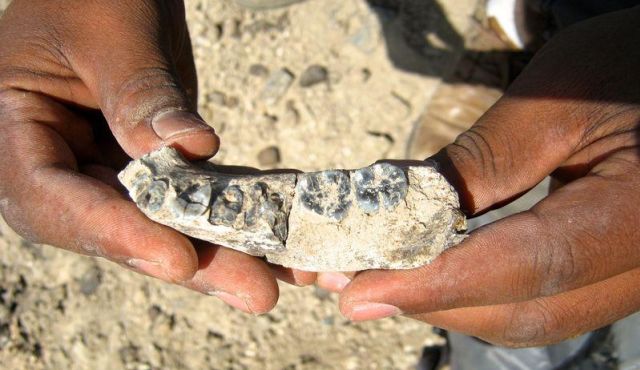Christian Post Report – The jawbone fossil, steps from where it was sighted by Chalachew Seyoum, an ASU graduate student from Ethiopia, in this undated photo.
Researchers claim that the earliest human remains, specifically a jawbone and a handful of teeth, have been discovered in Ethiopia and date back to 2.8 million year ago, which is almost 400,000 years older than previously thought.
“Prior to 3 million years, humans were relatively ape-like and partially arboreal, partially bipedal,” Brian Villmoare, who led the research, told Discovery News. “They lived in the forest, had small brains, and did not eat meat or use tools.”
He added that after 2 million years, “humans have large brains, stone tools, and eat meat, so this transitional period is very important in terms of human evolution.”
The remains of the teeth and the lower jaw fossil were discovered in the Ledi-Geraru research area at Afar Regional State, Ethiopia.
Villmoare, who’s a paleoanthropologist at the University of Nevada in Las Vegas, told Live Science that the discovery constitutes the earliest evidence of human lineage.
“There is a big gap in the fossil record between about 2.5 million and 3 million years ago — there’s virtually nothing relating to the ancestors of Homo from that time period, in spite of a lot of people looking,” he said.
The researchers, who published their findings in the journal Science, noted that they cannot say much about how this early human looked like based on the jawbone alone.
“But there does appear to have been a general reduction in skeletal and dental elements in this jaw, which is consistent with the transition to the Homo adaptive pattern,” Villmoare argued.
Researchers have said that humans likely evolved from the more ancient and ape-like Australopithecus, known famously as the “Lucy” discovery. Biblical creationists, such as the Creation Museum in Kentucky which features a holographic exhibit of “Lucy,” have argued that the ape-like creature is not the “missing link” for human evolution.
Villmoare, however, said that the fossil of the jawbone, labeled LD 350-1, dates to about 200,000 years after Lucy, and that the teeth and the proportions of the jaw suggest it belonged to the genus Homo rather than Australopithecus. He suggested that the specimen contains traits of both.
“Once we found it, we knew immediately what it was — we could tell it was a human ancestor,” the paleoanthropologist said. “We were jumping up and down the side of that hill.”
Source : Christian Post
